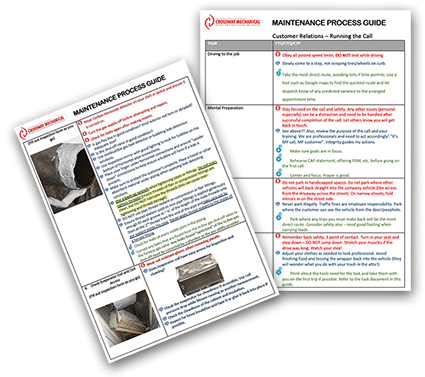From my experience working in manufacturing, research and development, and product support, I learned that non-conformance to specification is one of the primary causes of errors and product defects.
On the other hand, strict process control (consistent methods and clearly defined standards) yields consistent results. The outcome is always based on input. I had a manager who used to put it this way:
“If you do what you always did, you will get what you always got.”
What in the world does that mean? Here’s an example:
If you keep putting your shoes on without tying the shoelaces, then your shoes will keep falling off. Or (worst case) you may fall flat on your face! In other words, bad habits, bad practices, and half measures consistently yield poor (substandard) results.
Consistent Results

To deliver high-quality, high-performing HVAC systems, we must consistently apply best practices and go beyond industry code standards. Good design, proper application, and quality installation are the keys to having the right balance between reliability, operating efficiency, and comfort. It’s like a three-legged stool: if any one of these elements is weak or missing, the stool tips over (fails).
However, if it’s designed right, applied right, and installed right, it will work right!
It seems like a no-brainer, right?
WRONG! Making this come together takes considerable thought, with collaboration from the whole team. AND it may require a culture shift, a change from an inherited mindset. At Crossway Mechanical in Tomball, Texas, we recognized that we paid tremendous prices when we made mistakes.
As a result, we work hard to become a more process-driven organization that uses the Six Sigma (ncilink.com/6Sigma) process control methods to ensure consistent results.
Non-Conformance and the Price You Pay
So, what does non-conformance cost? With our “shoe’s untied” example, we might fall flat on our face, right in front of our paying customer who just spent good money for a properly installed comfort system. Is that what we want? No! We want to come off as polished, competent, and professional experts.
Non-conformance causes us to lose money because of costly warranty callback visits at company expense. Callbacks include all overhead costs (employee pay, vehicle wear-and-tear, gas, tolls, and the list goes on). I saw the following quote posted at a dealer in South Texas a long time ago:
“If you think you don’t have the (time) to do it right the first time, then how can you possibly have (time) to do it over?”
Non-conformance also has a cost in terms of valuable customer relationships.
Callbacks and other non-conformance issues create customer inconvenience. Ask yourself whether customers like service personnel in their homes more than planned, and possibly at inconvenient hours.
Inconvenient callbacks also lead to negative “word of mouth” reputation issues. You see that cost in terms of poor online reviews with the BBB, the neighborhood blog, social media, etc.
Finally, the cost of non-conformance impacts employee morale. Having to return to fix mistakes is a source of embarrassment to employees. What if we have to send them back on their own time? That hurts everybody!
Click Below for the Next Page:













Recent Comments